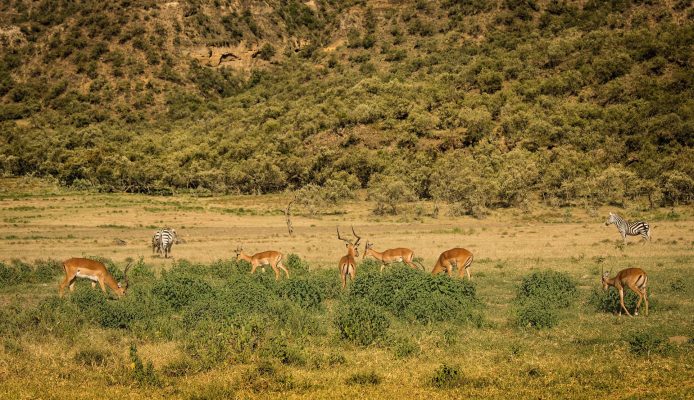Hell’s Gate National Park
Hell’s Gate National Park is a unique and captivating destination located just 90 kilometers (56 miles) northwest of Nairobi, near the town of Naivasha in Kenya. Established in 1984, the park spans approximately 68 square kilometers (26 square miles) and is renowned for its stunning landscapes, characterized by dramatic cliffs, gorges, and geothermal activity. The park gets its name from the impressive geological features, including the Hell’s Gate Gorge, which offers breathtaking views and opportunities for exploration. Hell’s Gate is one of the few parks in Kenya where visitors can walk or cycle freely among wildlife, making it an ideal destination for adventure seekers and nature lovers alike.

Wildlife in Hell’s Gate National Park
Hell’s Gate National Park is home to a diverse array of wildlife, making it a great spot for both casual observers and dedicated wildlife enthusiasts. The park hosts several species of large mammals, including zebras, buffaloes, giraffes, and antelopes such as Thomson’s gazelles and Grant’s gazelles. Although the park does not have the Big Five, it is rich in biodiversity, and visitors can often see wildlife up close while walking or biking through the park. Additionally, the park’s unique landscapes support various smaller mammals, reptiles, and insects, contributing to a vibrant ecosystem that is vital for conservation efforts.
Birds in Hell’s Gate National Park
Birdwatching is a highlight at Hells Gate National Park, with over 100 species of birds recorded in the area. The diverse habitats within the park, including grasslands, cliffs, and water bodies, provide ideal conditions for a variety of avian life. Notable bird species include the African fish eagle, Verreaux’s eagle, and the elusive ostrich. The park is also home to numerous smaller birds, such as hornbills, swifts, and weavers, making it a delightful destination for birdwatchers throughout the year. The best times for birdwatching are during the wet seasons when migratory species are present and resident species are active.
How To Get To Hell’s Gate National Park
Reaching Hells Gate National Park is relatively easy, given its proximity to Nairobi. The park is approximately 90 kilometers (56 miles) away, and the journey can be made by car or public transport. Visitors can drive from Nairobi via the Nairobi-Nakuru highway, taking about 1.5 to 2 hours, depending on traffic. For those without personal transportation, several tour operators offer shuttle services and guided tours that include transportation to and from the park. The nearest town, Naivasha, serves as a convenient base for visitors, providing accommodation and amenities.
Weather and Climate
Hell’s Gate National Park enjoys a pleasant climate, with temperatures typically ranging from 10°C to 26°C (50°F to 79°F). The park is situated at an altitude of approximately 1,500 meters (4,921 feet) above sea level, contributing to its moderate temperatures. The rainy seasons occur from March to May and October to December, bringing significant rainfall that nourishes the park’s vegetation. The dry seasons from June to September are generally warmer and provide excellent conditions for wildlife viewing as animals congregate around water sources. Visitors should come prepared for fluctuating temperatures, especially during early mornings and late evenings when it can get quite chilly.
Safety and Vaccination
Safety is an essential consideration for visitors to Hell’s Gate National Park. The park is generally considered safe for tourists, but it is recommended to stay within designated areas and to travel in groups. Guided walks and bike tours are available, providing an added layer of safety and expertise. Regarding health precautions, travelers should consult their healthcare providers for vaccinations before visiting Kenya. Recommended vaccinations may include yellow fever, hepatitis A, and typhoid. While the risk of malaria is lower in the park due to its altitude, it is advisable to take precautions if visiting lower-lying areas of Kenya where malaria is more prevalent.
Park Rules
To ensure the safety of both visitors and wildlife, Hell’s Gate National Park has established several rules and regulations. Visitors are required to stay on marked trails while walking or biking to minimize environmental impact. Feeding wildlife is strictly prohibited, as it can disrupt their natural behavior and lead to dangerous encounters. Loud noises should be avoided to respect the tranquility of the park and to prevent scaring away wildlife. Campfires and open flames are not allowed outside designated areas. Additionally, visitors should carry their trash out of the park to maintain its natural beauty and cleanliness.
Activities to Engage in Hells Gate National Park
Hell’s Gate National Park offers a wide range of activities for visitors to engage in, ensuring a memorable experience for everyone. Some popular activities include:
- Hiking and Nature Walks: The park has several designated walking trails that allow visitors to explore its scenic landscapes up close while observing wildlife in their natural habitat.
- Cycling: Biking is a popular activity in Hell’s Gate, with well-maintained paths available for cyclists of all skill levels. Visitors can rent bikes from local operators.
- Rock Climbing: The park features several climbing areas, including the Fischer’s Tower and the Hell’s Gate Gorge, attracting both novice and experienced climbers.
- Birdwatching: With a rich variety of bird species, the park offers excellent opportunities for birdwatching, making it a paradise for avian enthusiasts.
- Geothermal Exploration: Visitors can explore the geothermal features of the park, including hot springs and steam vents, providing a unique insight into the region’s geology.
- Photography: The stunning landscapes, diverse wildlife, and geological features create perfect opportunities for photography, making it a haven for both amateur and professional photographers.
These activities, combined with the park’s stunning scenery and diverse wildlife, make Hell’s Gate National Park a must-visit destination for those seeking adventure and a connection to nature.
